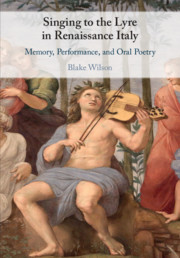Book contents
- Singing to the Lyre in Renaissance Italy
- Singing to the Lyre in Renaissance Italy
- Copyright page
- Contents
- Figures
- Tables
- Acknowledgments
- Abbreviations
- Introduction
- Part I The Canterino Tradition
- 1 Early History: Ioculatores and Giullari
- 2 The Trecento Canterino
- Excursus 1 Piazza San Martino: Performance, Place, and Audience in Florence
- 3 The Canterino in the Fifteenth Century
- Part II Cantare ad Lyram: The Humanist Tradition
- Bibliography
- Index
2 - The Trecento Canterino
from Part I - The Canterino Tradition
Published online by Cambridge University Press: 31 October 2019
- Singing to the Lyre in Renaissance Italy
- Singing to the Lyre in Renaissance Italy
- Copyright page
- Contents
- Figures
- Tables
- Acknowledgments
- Abbreviations
- Introduction
- Part I The Canterino Tradition
- 1 Early History: Ioculatores and Giullari
- 2 The Trecento Canterino
- Excursus 1 Piazza San Martino: Performance, Place, and Audience in Florence
- 3 The Canterino in the Fifteenth Century
- Part II Cantare ad Lyram: The Humanist Tradition
- Bibliography
- Index
Summary
During the thirteenth century the political forces of an older feudal nobility and an emergent guild-based republicanism had begun to vie for control within individual cities. By the early fourteenth century one or the other had gained the upper hand within a given city, and these shaped the new urban politics within which a new generation of oral poets emerged. For courtly performers like Antonio da Ferrara and Francesco di Vannozzo, these feudal environments provided a more traditional patronage environment that held oral poets to older patterns of chronic itinerancy, hybrid forms of entertainment, and poetic activity subject to the priorities of aristocratic patrons. The public and socially fluid environments of the commercial republics fostered a different sort of canterino, one more rooted in place, communally engaged with socially heterogeneous audiences, and reflective of a rapidly growing vernacular literary culture. The outstanding figure here is the Florentine canterino, Antonio Pucci. A section devoted to Dante, Boccaccio, and Petrarch reveals a surprisingly reciprocal engagement with oral poets, whose mixed orality made them important agents in the dissemination of the poetry and stylistic elements of the tre corone, while the literate culture of the time continued to be shaped by oral practice.
Keywords
- Type
- Chapter
- Information
- Singing to the Lyre in Renaissance ItalyMemory, Performance, and Oral Poetry, pp. 29 - 86Publisher: Cambridge University PressPrint publication year: 2019

